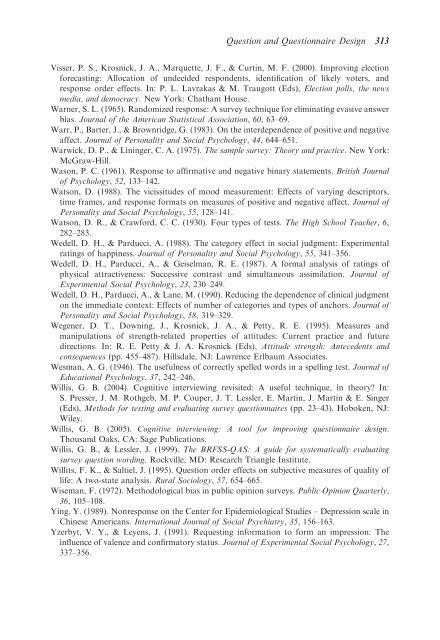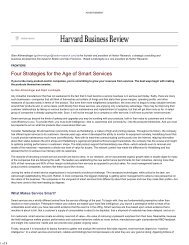Question and Questionnaire Design - Stanford University
Question and Questionnaire Design - Stanford University
Question and Questionnaire Design - Stanford University
Create successful ePaper yourself
Turn your PDF publications into a flip-book with our unique Google optimized e-Paper software.
<strong>Question</strong> <strong>and</strong> <strong>Question</strong>naire <strong>Design</strong> 313Visser, P. S., Krosnick, J. A., Marquette, J. F., & Curtin, M. F. (2000). Improving electionforecasting: Allocation of undecided respondents, identification of likely voters, <strong>and</strong>response order effects. In: P. L. Lavrakas & M. Traugott (Eds), Election polls, the newsmedia, <strong>and</strong> democracy. New York: Chatham House.Warner, S. L. (1965). R<strong>and</strong>omized response: A survey technique for eliminating evasive answerbias. Journal of the American Statistical Association, 60, 63–69.Warr, P., Barter, J., & Brownridge, G. (1983). On the interdependence of positive <strong>and</strong> negativeaffect. Journal of Personality <strong>and</strong> Social Psychology, 44, 644–651.Warwick, D. P., & Lininger, C. A. (1975). The sample survey: Theory <strong>and</strong> practice. New York:McGraw-Hill.Wason, P. C. (1961). Response to affirmative <strong>and</strong> negative binary statements. British Journalof Psychology, 52, 133–142.Watson, D. (1988). The vicissitudes of mood measurement: Effects of varying descriptors,time frames, <strong>and</strong> response formats on measures of positive <strong>and</strong> negative affect. Journal ofPersonality <strong>and</strong> Social Psychology, 55, 128–141.Watson, D. R., & Crawford, C. C. (1930). Four types of tests. The High School Teacher, 6,282–283.Wedell, D. H., & Parducci, A. (1988). The category effect in social judgment: Experimentalratings of happiness. Journal of Personality <strong>and</strong> Social Psychology, 55, 341–356.Wedell, D. H., Parducci, A., & Geiselman, R. E. (1987). A formal analysis of ratings ofphysical attractiveness: Successive contrast <strong>and</strong> simultaneous assimilation. Journal ofExperimental Social Psychology, 23, 230–249.Wedell, D. H., Parducci, A., & Lane, M. (1990). Reducing the dependence of clinical judgmenton the immediate context: Effects of number of categories <strong>and</strong> types of anchors. Journal ofPersonality <strong>and</strong> Social Psychology, 58, 319–329.Wegener, D. T., Downing, J., Krosnick, J. A., & Petty, R. E. (1995). Measures <strong>and</strong>manipulations of strength-related properties of attitudes: Current practice <strong>and</strong> futuredirections. In: R. E. Petty & J. A. Krosnick (Eds), Attitude strength: Antecedents <strong>and</strong>consequences (pp. 455–487). Hillsdale, NJ: Lawrence Erlbaum Associates.Wesman, A. G. (1946). The usefulness of correctly spelled words in a spelling test. Journal ofEducational Psychology, 37, 242–246.Willis, G. B. (2004). Cognitive interviewing revisited: A useful technique, in theory? In:S. Presser, J. M. Rothgeb, M. P. Couper, J. T. Lessler, E. Martin, J. Martin & E. Singer(Eds), Methods for testing <strong>and</strong> evaluating survey questionnaires (pp. 23–43). Hoboken, NJ:Wiley.Willis, G. B. (2005). Cognitive interviewing: A tool for improving questionnaire design.Thous<strong>and</strong> Oaks, CA: Sage Publications.Willis, G. B., & Lessler, J. (1999). The BRFSS-QAS: A guide for systematically evaluatingsurvey question wording. Rockville, MD: Research Triangle Institute.Willits, F. K., & Saltiel, J. (1995). <strong>Question</strong> order effects on subjective measures of quality oflife: A two-state analysis. Rural Sociology, 57, 654–665.Wiseman, F. (1972). Methodological bias in public opinion surveys. Public Opinion Quarterly,36, 105–108.Ying, Y. (1989). Nonresponse on the Center for Epidemiological Studies – Depression scale inChinese Americans. International Journal of Social Psychiatry, 35, 156–163.Yzerbyt, V. Y., & Leyens, J. (1991). Requesting information to form an impression: Theinfluence of valence <strong>and</strong> confirmatory status. Journal of Experimental Social Psychology, 27,337–356.
















